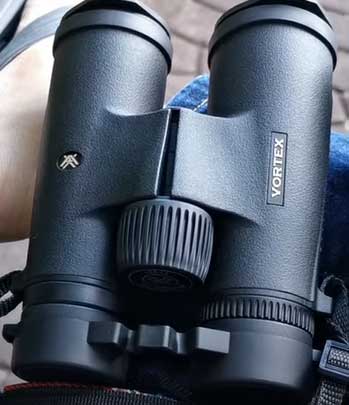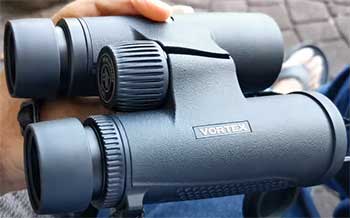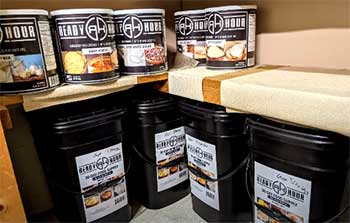Binoculars are an essential tool for nature enthusiasts, bird watchers, hunters, and sports spectators. With so many options on the market, it can be tricky to decide which pair is right for your needs and budget.
Two popular binocular brands are Vortex and Crossfire. But how do their mid-range models, the Vortex Copperhead and Crossfire binoculars, compare?
In this comprehensive guide, we’ll break down the key features and performance of the Vortex Copperhead and Crossfire binoculars. We’ll compare optical quality, durability, weight, accessories, and more.
We’ll also overview when each pair excels to help you determine which is a better fit for your intended use.
A Brief Comparison Table
| Feature | Vortex Copperhead | Crossfire Binoculars |
| Weight | 22 oz | 17.8 oz |
| Housing Material | Aircraft-grade aluminum | Polycarbonate composite |
| Waterproof/Fogproof | Yes | Yes |
| Field of View | 314 ft @ 1000 yds | 330 ft @ 1000 yds |
| Close Focus | 5 ft | 6 ft |
| Eye Relief | 15mm | 15mm |
| Prism Type | Phase corrected roof | Roof |
| Coatings | Fully multi-coated | Fully multi-coated |
| Shockproof | Yes | No |
| Tripod Adaptable | With accessory adapter | With accessory adapter |
| Warranty | Unlimited lifetime warranty | 10 years limited |
| Carrying Case | Padded case | Unpadded case |
| Lens Covers | Rainguard, tethered covers, eyepiece covers | Rainguard, tethered covers |
| Optical Quality | Excellent | Very good |
| Low Light Performance | Excellent | Good |
| Durability | Excellent | Good |
Vortex Copperhead Binoculars Overview
The Vortex Copperhead binoculars offer quality optics and durability at a mid-range price point. Here are some of the key specs and features of this model:

- Magnification: 10x
- Objective lens diameter: 42mm
- Field of view: 314 feet/1000 yards
- Close focus: 5 feet
- Eye relief: 15mm
- Weight: 22 oz
- Waterproof: Yes, O-ring seals prevent moisture, dust, and debris from getting inside
- Fog proof: Yes, argon gas purging prevents internal fogging
- Prism type: Roof
Some standout benefits of the Copperhead binoculars:
- Fully multi-coated lenses: Multiple anti-reflective coatings on all air-to-glass surfaces enhance light transmission for bright, clear images.
- Phase corrected roof prisms: Improve resolution and contrast.
- Textured grip areas: The rubber armor coating provides a secure grip.
- Adjustable eye cups: Twist up and down for proper eye relief with or without glasses.
- Right eye diopter adjustment: Fine-tune focus for your right eye.
- Tripod adaptable: Use an optional adapter to mount the binos on a tripod or car window mount.
Overall, the Copperhead binoculars offer excellent optics and usability in a lightweight, durable package. While not quite top-tier, their performance punches above their price point.
Crossfire Binoculars Overview
Here are the key specs and features of the Crossfire roof prism binoculars:
- Magnification: 10x
- Objective lens diameter: 42mm
- Field of view: 330 feet/1000 yards
- Close focus: 6 feet
- Eye relief: 15mm
- Weight: 17.8 oz
- Waterproof: Yes, O-ring seals keep out moisture
- Fog proof: Yes, nitrogen gas purging prevents fogging
- Prism type: Roof
Benefits of the Crossfire binoculars:
- Fully multi-coated optics: Increase light transmission for bright views.
- Wide field of view: Enjoy expansive views.
- Non-slip grip: Textured rubber armor provides a secure hold.
- Adjustable eye cups: Twist up and down for use with or without eyeglasses.
- Center focus knob: Easily fine-tune focus.
- Tripod adaptable: Use with an optional adapter.
- Affordable price: Budget-friendly compared to premium binoculars.
The Crossfire binoculars are a reasonably priced option offering fully multi-coated lenses and waterproof/fog proof construction. While the optics and build quality aren’t on par with Vortex’s high-end offerings, their performance is very good for the price.
Optical Quality Comparison
Let’s take a deeper look at how the optics compare between the two models:

- Clarity and resolution: The Copperhead offers slightly better clarity, sharpness, and color accuracy. Its phase corrected roof prisms and premium fully multi-coated lenses provide excellent resolution of fine details. The Crossfire also has nice optics for its class, but its views aren’t quite as crisp.
- Low light performance: Both work reasonably well in low light conditions thanks to their light transmission coatings. The Copperhead’s larger 42mm lenses let in a bit more light for better nighttime viewing.
- Field of view: The Crossfire has a slightly wider FOV at 1000 yards (330 ft vs. 314 ft). This gives you a broader perspective when scanning open landscapes or tracking animals. The Copperhead has a more limited but still respectable field of view.
- Eye relief: Both models have a 15mm eye relief, adequate for eyeglass wearers.
- Close focus: You can get closer to your subject with the Crossfire, with a close focus of 6 feet vs. the Copperhead’s 5 feet minimum. This allows you to view smaller nearby objects in finer detail.
Overall, the Copperhead bins inch ahead in terms of optical clarity and resolution. But the Crossfire holds its own with perks like a wider field of view and closer minimum focus distance.
Durability Comparison
Ruggedness is important for bins used outdoors. Here’s how the Vortex Copperhead and Crossfire models compare:
- Waterproof/fog proof: Both are o-ring sealed and internally purged with gas to prevent moisture and fogging. They can withstand wet conditions like rain, snow, or boating.
- Shock resistance: The Copperhead is better shockproofed to withstand bumps and drops. Its rubber armored chassis absorbs impacts without damage. The Crossfire is not shockproof but its rubber coating offers some protection. Handle both carefully.
- Body material: The Copperhead features aircraft-grade aluminum housing, while the Crossfire is made of polycarbonate composite. The Copperhead’s metal construction makes it more durable.
- Lens coatings: Fully multi-coated on both, enhancing scratch resistance and repelling oil and dirt. The Copperhead’s lenses hold up better over time.
The Copperhead wins out in terms of ruggedness. Its aircraft-grade housing and advanced shockproofing let it better withstand regular outdoor use and accidental drops. While not overly fragile, the Crossfire bins require a bit more care.
Also Read: Is Celestron Better Than Vortex Binocular?
Ergonomics and Handling Comparison
Comfort and usability are important for enjoying your optics:
- Chassis design: Both have roof prism designs that are compact, balanced, and easy to handle. The Copperhead’s curved chassis fits nicely in the hands.
- Weight: At 22 oz, the Copperhead is heavier but still comfortable for extended carrying. The Crossfire is very light at just 17.8 oz.
- Rubber armor: Both models have a textured rubber coating for a secure grip, even with wet hands. The Crossfire’s armor has a bit more tactile texture.
- Eye cups: Their twist-up eye cups work well for using them with or without glasses. The Crossfire’s cups have a ribbed texture for easier gripping when adjusting.
- Focus knob: Located on top, both focus knobs turn smoothly for quick adjustments. The Copperhead’s oversized knob is especially easy to use with gloves on.
For ergonomics and handling, there’s no clear winner. The Copperhead offers a beefier yet still comfortable chassis, while the Crossfire is super light. The Crossfire’s grip and eye cups are a bit more tactile for easy adjustments without looking. Choose based on your hand size and weight preference.
Accessories Comparison
Let’s compare what’s included with each model:

- Carrying case: The Copperhead includes a padded case with both a shoulder strap and belt loop. The Crossfire has a simpler unpadded slip-in case.
- Neck strap: Both include an adjustable neck strap. The Copperhead’s is wider and more comfortable.
- Lens covers: Both come with a rainguard and tethered objective lens covers. The Copperhead also includes soft microfiber eyepiece covers.
- Cleaning cloth: A handy microfiber cloth is included with both models.
- Tripod adapter: You’ll need to purchase a tripod adapter separately for both binoculars.
- Warranty: Vortex’s impressive unconditional lifetime warranty beats Crossfire’s more limited 10-year warranty.
The Copperhead pulls ahead here. While both include the essentials, the Copperhead bundles a high-quality padded case and more protective lens covers. And Vortex’s unlimited warranty provides better long-term value.
Price Comparison
As of this writing in 2023, the retail prices are:
- Vortex Copperhead: $299
- Crossfire Binoculars: $159
The Copperhead costs nearly twice as much as the Crossfire. The Vortex offers better optics and construction quality to justify the higher price. But the Crossfire gives you solid performance at a budget-friendly price point.
Keep resale value in mind too. If you ever want to sell or trade them in, the Copperhead will retain more of its original value over time. Vortex optics hold value well due to their reputation and unlimited warranty.
Which Is Better For Different Uses?
Now that we’ve compared features and performance, here is a quick overview of which model excels for different use cases:
- Bird watching: The Copperhead, with its superior resolution and close focus
- Hunting: The Copperhead, for its ruggedness and quality optics in low light
- Hiking: The lighter Crossfire for packing on long treks
- Concerts/events: The Crossfire for its smooth focusing and wider field of view
- Astronomy: The Copperhead for its sharpness on lunar/planetary details
- Butterfly/insect viewing: The Crossfire for extremely close focus ability
- Casual use: The affordable Crossfire for sporting events or travel
- Kids: The durable, affordable Crossfire for family excursions
As you can see, the Copperhead’s better clarity and rugged build make it preferable for technical nature viewing and outdoor pursuits. But the Crossfire’s smooth performance and lower cost work great for casual use.
Also Read: Is Fujinon Better Than Canon Image Stabilized Binocular?
Frequently Asked Questions (FAQ)
Yes, the Vortex Diamondback series is a step up from the Crossfire line and offers better optical clarity, low light performance, and durability. The Diamondback has premium features like phase corrected roof prisms, while the Crossfire has standard roof prism design.
The Vortex Viper binoculars are several tiers above the Crossfire line and offer superior optics, ruggedness, and design. Key advantages of the Viper include a wide field of view,XD glass for color and resolution, and strong yet lightweight magnesium chassis. The Viper costs significantly more than the Crossfire.
The closest equivalent Vortex binocular to the Crossfire line would be the Diamondback series. The Vortex Diamondback offers better optics and construction than the Crossfire for a moderate step up in price. Both lines offer good value at their respective price points.
Vortex is the brand name and Diamondback is one of their binocular product lines. Vortex produces a wide range of sport optics and is known for quality at various price points. The Diamondback binoculars occupy Vortex’s middle tier: above Crossfire but below the premium Viper and Razor models.
The Bottom Line
While the Crossfire binoculars perform admirably for the price, the Vortex Copperhead is worth the extra investment if optical quality is critical for your intended use. The Copperhead excels for nature viewing and outdoor activities thanks to its sharpness, low light capabilities, close focus, and rugged build.
The Crossfire line can still serve well for casual use, events, and family adventures. And they offer decent optics in a super lightweight package. Budget-minded buyers can feel comfortable choosing the Crossfire bins.
We hope this comprehensive comparison helps you decide which model best suits your needs and budget. Both Vortex and Crossfire offer reputable products. While the Copperhead has the performance edge, choose the pair that aligns with how you plan to use them.


